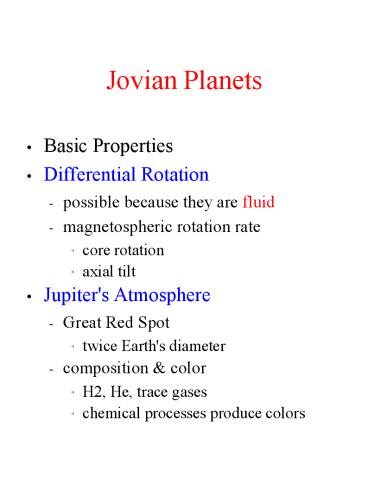Jovian Planets - PowerPoint PPT Presentation
1 / 10
Title:
Jovian Planets
Description:
Jupiter's Atmosphere. Zones & Belts. due to convective motions ... Jupiter. emits about twice as much energy as it receives. heat left over from formation ... – PowerPoint PPT presentation
Number of Views:204
Avg rating:3.0/5.0
Title: Jovian Planets
1
Jovian Planets
- Basic Properties
- Differential Rotation
- possible because they are fluid
- magnetospheric rotation rate
- core rotation
- axial tilt
- Jupiter's Atmosphere
- Great Red Spot
- twice Earth's diameter
- composition color
- H2, He, trace gases
- chemical processes produce colors
2
- Jupiter's Atmosphere
- Zones Belts
- due to convective motions
- different heights gt different temps gt different
colors - zonal flow
- equatorial speed jet stream
- disappears near poles
- atmospheric structure
- color depth
- stratosphere
- haze layer
- troposphere
- weather convection
- color layers
- weather patterns
- hurricanes
- supported by large-scale atmospheric motion
3
- Weather patterns
- white ovals
- brown ovals - 20o North
- lack of continents gt long life
4
Jovian Atmospheres
- Saturn
- banded, with storms, not as colorful
- hydrogen helium dominate
- helium depletion
- colder temps
- lower gravity gt thicker layers
- equatorial zonal flow _at_ 1500 km/h
- Uranus Neptune
- same general composition
- methane provides colors
- no ammonia (due to lower temps)
5
- Uranus
- clouds at lower levels
- hard to see structure/bands
- flow patterns in rotation direction
- speeds 200-500 km/h
- Neptune
- slightly warmer upper atmosphere
- thinner haze layer
- cloud layers less dense
- equatorial winds
- retrograde
- 2000 km/h
- Great Dark Spot
6
Jovian Interiors
- Cloud cover few hundred km
- Internal Structure
- temp pressure increase with depth
- 20,000 km
- pressure is 3 mill times greater than on Earth
- hydrogen in metallic state
- dense core
- 10 times Earth's mass
- molten rock terrestrial planets
- pressure 50 million times Earth's
- about 20,000 km in diameter
- rotation creates equatorial bulge ( 7 )
7
- Saturn
- metallic hydrogen layer is thinner
- central dense core 15 Earth masses
- lower mass gt less extreme core temp, density,
pressure - Uranus Neptune
- no metallic layer
- slushy interiors
- thick layers of highly compressed water clouds
- possibly ammonia dissolved in water
- cores 10-15 Earth masses
- Magnetospheres
- Jupiter
- rapid rotation conductive fluid
- strongest planetary field
- extensive magnetosphere
8
- Magnetospheres
- Saturn
- smaller mass of metallic hydrogen zone
- 1/20 Jupiter's field
- Uranus Neptune
- strong fields
- Internal Heating
- Jupiter
- emits about twice as much energy as it receives
- heat left over from formation
- Saturn
- radiates 3 times what it absorbs
- not hot enough to dissolve liquid helium
- helium rain 2 billion years ago
- compressional gravitational heating
- Uranus
- no internal heat source
9
- Internal Heating
- Neptune
- emits 2.7 times what it receives
- methane insulation??
10
Pluto
- 40 A.U. From Sun
- bright polar caps/possible craters
- Charon
- largest satellite to planet mass ratio
- tidally locked
- 6.4 days
- captured similar to Earth's Moon
- retrograde rotation
- comparable in mass size to Jovian moons
- Kuiper Belt object?































